|Australia home|
|Sydney, Blue Mts|
|Fraser Island|
|Outback|
|Litchfield & Kakadu|
|Singapore|
Click on one of the links above (or in the map)
for more details on any particular area we visited. On this
page, you'll find the following (links within this page):
Description of our 3-day scuba
diving trip at the Great Barrier Reef.
The organization we went with,
a description of the ship, and practicalities. Also, where we
stayed in Bundaberg.
Photographs - a little larger than
the ones you see in the description of the trip. (I put the
photographs at the end of this page, so they'll load as you read.)
Description of our trip: Scuba
diving at the Great Barrier Reef
Our three-day diving trip at the southern end of the Great Barrier Reef was definitely one of the best parts of our entire trip. We did ten dives, in two full days and one morning. Two of the dives were night dives. The dives were excellent, with a wealth of beautiful underwater flora and fauna. Some of the highlights were seeing two manta rays, a spanish dancer, and an octopus, and swimming with turtles.
Friday, september 6th, 2002.
We arrived in Bundaberg around sunset, had dinner, and drove over to Salty's. Salty's is the organization with which we did 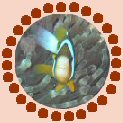 our three-day diving trip on the southern Great Barrier Reef. We were first asked to sign lots of forms saying that Salty's is not responsible for anything, no matter what happens, and then spent some time putting together everyone's gear, fitting wetsuits, and such. We then drove over to the harbor. our three-day diving trip on the southern Great Barrier Reef. We were first asked to sign lots of forms saying that Salty's is not responsible for anything, no matter what happens, and then spent some time putting together everyone's gear, fitting wetsuits, and such. We then drove over to the harbor.
Salty's diving boat is the Venus II, a fairly large and sturdy-looking ship. Eric and I shared a little room (I'm sure there's a nice nautical term for that...) with a Chech, Oskar, and a fellow from Bundaberg, Clive. The four of us also
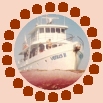 shared a bathroom, with a shower. Apart from the four of us, there was a Korean couple, and a group of about 7 Japanese divers. There were also two instructors, Kris (for the non-Japanese) and Keiko (for the Japanese), and Leo and Dale ran the boat and did the cooking. We all "checked" into our rooms, fought over the beds, and appeared back upstairs in the common room for an introduction to the ship rules, just as the boat was leaving the dock.
shared a bathroom, with a shower. Apart from the four of us, there was a Korean couple, and a group of about 7 Japanese divers. There were also two instructors, Kris (for the non-Japanese) and Keiko (for the Japanese), and Leo and Dale ran the boat and did the cooking. We all "checked" into our rooms, fought over the beds, and appeared back upstairs in the common room for an introduction to the ship rules, just as the boat was leaving the dock.
The plan was simple: the ship was going to travel to the Reef overnight, from eleven to six in the morning. We were supposed to get up at six, have breakfast, and start diving! Eric and I, and our room-mates Oskar and Clive, went right to bed.
Saturday, september 7th, 2002.
Man, it was a rough night. The noise from the ship's engine wasn't too bad, but the movement of the waves had us rolling around in bed all night, and kept us awake. I slept for maybe two hours. We forced down some breakfast while gazing blindly 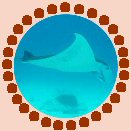 at the early morning light over Hoskyn Island, and then started fixing up our diving gear. It had been a while, for Eric
and me, and it took us a moment to figure out how everything worked. Squeeze into a wetsuit, put on the belt with lead, attach the regulator to the BCD... It's a good thing Kris helped us out. We then shuffled over to the side of the ship on our flippers (seeing a diver walking around with full gear on a solid surface always convinces me that human beings did not evolve specifically for living underwater), and hopped overboard. at the early morning light over Hoskyn Island, and then started fixing up our diving gear. It had been a while, for Eric
and me, and it took us a moment to figure out how everything worked. Squeeze into a wetsuit, put on the belt with lead, attach the regulator to the BCD... It's a good thing Kris helped us out. We then shuffled over to the side of the ship on our flippers (seeing a diver walking around with full gear on a solid surface always convinces me that human beings did not evolve specifically for living underwater), and hopped overboard.
This was not an easy dive. I had trouble equalizing my ears, and there was a tough current; the Korean girl and I had trouble keeping up with the rest, even though I was swimming as fast as I could. I didn't really notice much of anything under water, as I was just concentrating on keeping up with the group. It was a little tense.
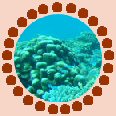 Back on the boat, everyone agreed that the current was too strong, and we lifted the anchor and went over to Fairfax Island, a few miles further on. The current was much less strong over here, and this time we had a very relaxing dive, enjoying the beautiful fish and coral. We saw millions of butterfly fish; even though these are considered to be very common and unremarkable, I find them beautiful as well, as they are so colorful. Our third dive was also off Fairfax Island.
Back on the boat, everyone agreed that the current was too strong, and we lifted the anchor and went over to Fairfax Island, a few miles further on. The current was much less strong over here, and this time we had a very relaxing dive, enjoying the beautiful fish and coral. We saw millions of butterfly fish; even though these are considered to be very common and unremarkable, I find them beautiful as well, as they are so colorful. Our third dive was also off Fairfax Island.
Everything was organized very well, on the ship. Whenever the Japanese went diving, our instructor was on the ship, and vice versa, so that there was always one of them on board. We all carried diving computers, that logged our maximum depth, bottom time, ascending rate, etc, and everything was noted after a dive. Our pressure groups were calculated, and the
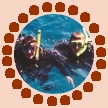 surface time before we were allowed to dive again. We stuck to the diving rules very carefully, including a three-minute wait at a depth of 5 meters, when coming up.
surface time before we were allowed to dive again. We stuck to the diving rules very carefully, including a three-minute wait at a depth of 5 meters, when coming up.
I was exhausted, and slept for a while in between dives. Several others did the same, and one or two people even skipped a few dives, to rest. Then, when it was dark (around six), it was time for our night dive! Eric and I were combining this trip with an Advanced PADI diving course, and the night dive was part of it. Stumbling about in the dark, with about 20 kilograms of gear on my back and the deck heaving below my flippers, I felt a little disoriented and apprehensive, and I
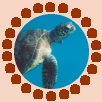 was happy to jump overboard. There were four of us: Kris (the instructor), Oskar, and Eric and I. We all had glow-sticks attached to our tanks, so we could see each other. Kris had attached glow-sticks to the anchor line as well, for us to follow to the bottom. The swimming was really tough: I was going at full force, just to keep up with the three men. I even used my arms, and swiped one of them across the top of a piece of coral - the coral didn't break, but I cut my fingers and palm, and a cloud of blood dispersed through the water, in the beam of my flashlight.
was happy to jump overboard. There were four of us: Kris (the instructor), Oskar, and Eric and I. We all had glow-sticks attached to our tanks, so we could see each other. Kris had attached glow-sticks to the anchor line as well, for us to follow to the bottom. The swimming was really tough: I was going at full force, just to keep up with the three men. I even used my arms, and swiped one of them across the top of a piece of coral - the coral didn't break, but I cut my fingers and palm, and a cloud of blood dispersed through the water, in the beam of my flashlight.
When we'd swum a ways away from the boat, it was time for a little exercise: we all sat on our knees on a sandy patch, turned off our flashlights, and waved our arms over our heads like a bunch of idiots. In the wake of our arms, we saw
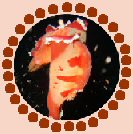 swooshes of green lights in the water: fluorescence! Then, as we drifted back to the ship on the current, we got a chance to look around, and we spotted a turtle in a cave.
swooshes of green lights in the water: fluorescence! Then, as we drifted back to the ship on the current, we got a chance to look around, and we spotted a turtle in a cave.
Getting back onto the ship was another challenge. The ship's crew were already waiting for us, to help out, and announced that the wind had picked up a bit in the past twenty minutes. In addition, it was maximum tide, hence the strong current. No kidding. As we watched from the water, the ship heaved up and down. I would normally have preferred to keep clear of there, but we had to get onto the boat. We tossed our fins toward the crew, and then went up the ladder one by one. It was a matter of accurate timing. We jumped onto the ladder just as it neared its lowest point, and were then heaved up out of the water by a wave. It was essential to use this moment to run up the ladder to where the crew grabbed our shoulders, before the stern of the ship was plunged back into the waves. It was scary, but we all got onto the ship without any problems.
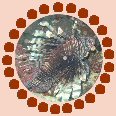 When I came into the common room after a shower, and smelled food, I suddenly felt sick, and I ran outside and hung over the railing, "feeding the fish." In my case I believe it was exhaustion rather than seasickness, as I felt better after a while, and even ate. Several divers did not show up for dinner, but were ill in their beds, and several of us looked pale and were having trouble holding down their dinners. Exhausted, all of the divers went to bed right after dinner.
When I came into the common room after a shower, and smelled food, I suddenly felt sick, and I ran outside and hung over the railing, "feeding the fish." In my case I believe it was exhaustion rather than seasickness, as I felt better after a while, and even ate. Several divers did not show up for dinner, but were ill in their beds, and several of us looked pale and were having trouble holding down their dinners. Exhausted, all of the divers went to bed right after dinner.
Sunday, september 8th, 2002.
The plan had been to set course for Lady Musgrave Island at 5 in the morning, but the crew lifted the anchor around 2, started the engine, and started plunging through the waves again, keeping us awake. There was a very good reason, however:
 a sailing ship had hit the reef at Lady Musgrave, there was a hole in the hull, and it was making water. It had broadcast an emergency message, and our ship was closest, so we went over there to help them out. They were allright in the end, and even succeeded in sailing to the coast by themselves, but it must have been comforting, through the night, to have another ship nearby.
a sailing ship had hit the reef at Lady Musgrave, there was a hole in the hull, and it was making water. It had broadcast an emergency message, and our ship was closest, so we went over there to help them out. They were allright in the end, and even succeeded in sailing to the coast by themselves, but it must have been comforting, through the night, to have another ship nearby.
After breakfast, Eric and I did a deep dive, for our diving course. We went down to 24 meters with Kris, and were confronted with the water pressure at that depth, by watching the compression of a plastic bottle, and feeling our wetsuits. It looked like Eric had some trouble with Nitrogen narcosis: it took him almost thirty seconds to write his name
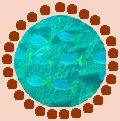 backward on a slate. I, on the other hand, experienced another symptom of deep diving: euphoria. I don't think Eric and Kris noticed, but I pretended to be an airplane for a while, swimming behind them with my arms stretched out sideways, and making soft humming sounds through the regulator... It was a great dive, and I now understand the dangers of deep diving...
backward on a slate. I, on the other hand, experienced another symptom of deep diving: euphoria. I don't think Eric and Kris noticed, but I pretended to be an airplane for a while, swimming behind them with my arms stretched out sideways, and making soft humming sounds through the regulator... It was a great dive, and I now understand the dangers of deep diving...
Our second dive was "fish identification." Click here for a good site on fish identification. Recognizing fish is a lot harder than it seems; however, we also found out that it's easy compared to navigation. This was the first time ever that Eric and I went on a dive without a guide or instructor. We had discussed the navigation beforehand, and we paid attention to the corals and our compass, but still we succeeded in getting  lost underwater. There was never any danger, of course, as we could have surfaced and spotted the ship, but still, I believe we have always underestimated the difficulty with underwater navigation.
lost underwater. There was never any danger, of course, as we could have surfaced and spotted the ship, but still, I believe we have always underestimated the difficulty with underwater navigation.
Three divers, who had been sea-sick all night, had been taken to Lady Musgrave Island in the morning, so they could enjoy solid ground beneath their feet for a while. They were picked up around noon, and felt a lot better. Lady Musgrave is an atol. It's a ring of coral, most of which is under water at high tide, and barely above the water at low tide. One section is always above the water, and that's the "Island." The islands we visited yesterday are also just bits of coral that stick out above the water; apparently, there's just a bit of soil, and a lot of bird shit covering the coral.
Although our morning dives had been along the outside of the Lady Musgrave atol, we moved inside the atol, into the lagoon, after lunch. Inside the ring of coral, the bottom is mostly sand; this is where we did an underwater navigation exercise, in which we were forced to use our compasses. After this dive, we had a fairly long surface interval, and Eric and I went
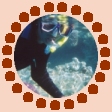 snorkelling around a bommie (that's a coral outcrop in the sandy bottom). We were neutrally buoyant, wearing our wetsuits, and could lie perfectly still for a while: this way, you get to see much more of the underwater animals than when you're busily splashing about. This time we were treated to a turtle that came near enough to touch (you mustn't touch them, though). I had quite a chance to study this wise-looking animal, following him at a fair distance for over half an hour, just watching.
snorkelling around a bommie (that's a coral outcrop in the sandy bottom). We were neutrally buoyant, wearing our wetsuits, and could lie perfectly still for a while: this way, you get to see much more of the underwater animals than when you're busily splashing about. This time we were treated to a turtle that came near enough to touch (you mustn't touch them, though). I had quite a chance to study this wise-looking animal, following him at a fair distance for over half an hour, just watching.
After sunset, it was time for another night dive! This time, however, there was little current and surge, and it was
fantastic. We swum about in the black water, watched the fish, and I spotted an octopus (or squid). The highlight, however, was a spanish dancer. This animal looks a little like a red, orange, and white rag floating around in the water: wow, very
 remarkable. One of the Japanese divers, Kazuyo Tokura, had an underwater camera, and took a wonderful picture. Great picture, Kazuyo, and thanks for letting me use it!
remarkable. One of the Japanese divers, Kazuyo Tokura, had an underwater camera, and took a wonderful picture. Great picture, Kazuyo, and thanks for letting me use it!
Monday, september 9th, 2002.
When we got up this morning, the ship was moored off Lady Elliot Island. Our last two dives were here, at the Lighthouse Bommie - these were dives 9 and 10 of the entire trip. I believe that this was the best spot of all. Beautiful coral, and countless colorful fish gave us just too much to look at. And... on our very last dive, we finally spotted a manta ray! It came floating by us, and we tried to prolong the time we could look at it, by swimming after it. We were finning as fast as we could, gulping away at the air in our tanks, but the manta ray flicked the ends of its wings and sped off without leaving even the slightest bit of turbulence behind. Incredible. This procedure was repeated about five minutes later, when  we saw yet another manta ray (or perhaps the first had returned). These animals are so sleek and fast, it makes human divers completely laughable.
we saw yet another manta ray (or perhaps the first had returned). These animals are so sleek and fast, it makes human divers completely laughable.
Unfortunately, this is where our diving trip came to an end. It took about six hours to go back to Bundaberg, during which Eric and I did the theoretical exam for our diving course. We then brought the gear back to Salty's, cleaned it, and that was it. Eric and I then went into Bundaberg to celebrate (we felt like sailors who have arrived in port and want to party), but the town was practically deserted, and we ended up in the RSL club.
Practicalities
Our diving trip was organized by Salty's, out of Bundaberg. We spent three nights
on their ship, the Venus II. The ship is comfortable, with berths downstairs and a
large dining room. We had two full days of diving (with 4 dives each), and
a morning of diving (2 dives). Check out
Salty's site
for more information (such as the cost).
Caravan parks in Bundaberg: Finemore Caravan Park, at a walking distance from
the center of town.
Photographs - Scuba diving at
Great Barrier Reef
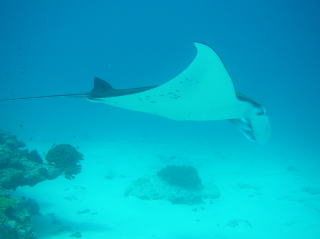
A manta ray (photo by Kazuyo, one of the other divers)
.
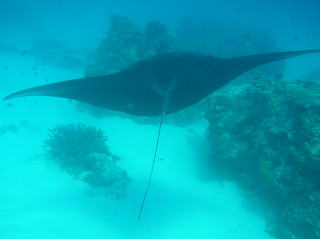
Another manta ray, or the same one, lateron? (photo by
Kazuyo)
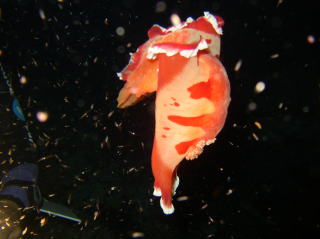
A spanish dancer, photographed during a night dive,
illuminated by flashlights. Note the fluorescence in
the water (photo by Kazuyo)
.
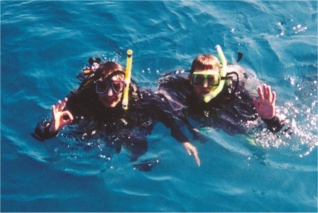
Ready to go under
!
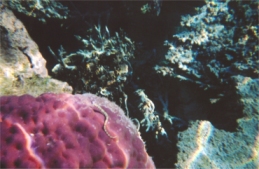
Coral (and unidentified thingy) on a bommie in the Lady
Musgrave Island atol
.
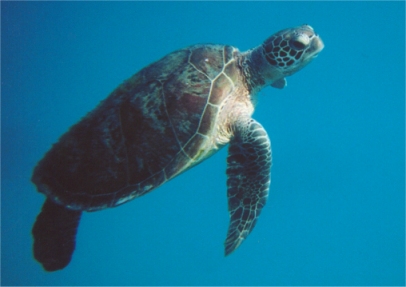
Turtle
.

Fusilier fish near a bommie (photo by Kazuyo)
.
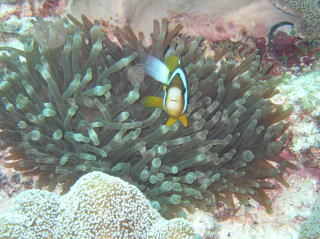
A curious Barrier Reef anemonefish peering up at the camera
(photo by Kazuyo)
.
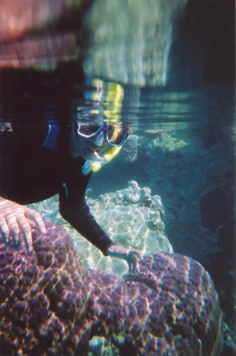
Snorkelling, while we wait for the next dive (surface interval)
..
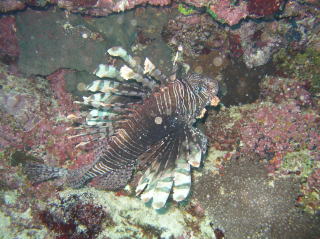
A firefish, perhaps devil firefish? (photo by Kazuyo)
.

Coral on a bommie (photo by Kazuyo).
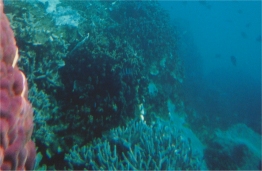
Coral on a bommie in the Lady Musgrave Island lagoon
.
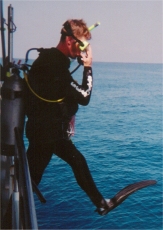
Stepping off the boat
.
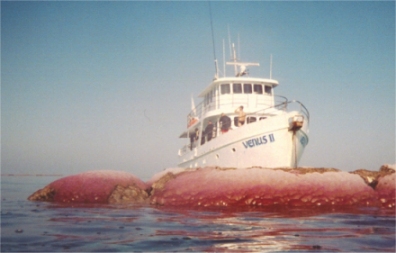
Salty's diving boat.
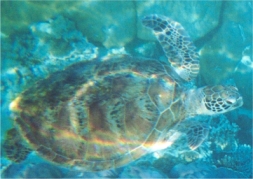
Turtle (photographed while snorkelling in the Lady
Musgrave Island atol).
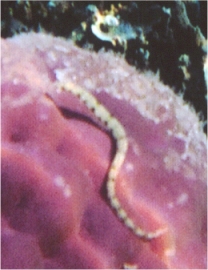
A pipe fish? Or a sea horse? Either way, it's on a bommie
in the Lady Musgrave Island atol. I'd appreciate it if
someone can tell me what this is (email me through my
home page
.
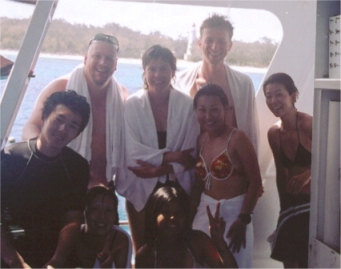
A few of the divers.
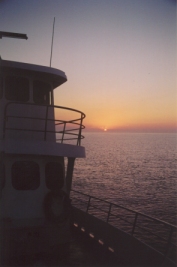
Sunset over the Great Barrier Reef.
|Judith home|
|Canada|
|Portugal & Spain|
|Sweden|
|Nepal|
|cycling Holland to Spain|
|
email me|
|


